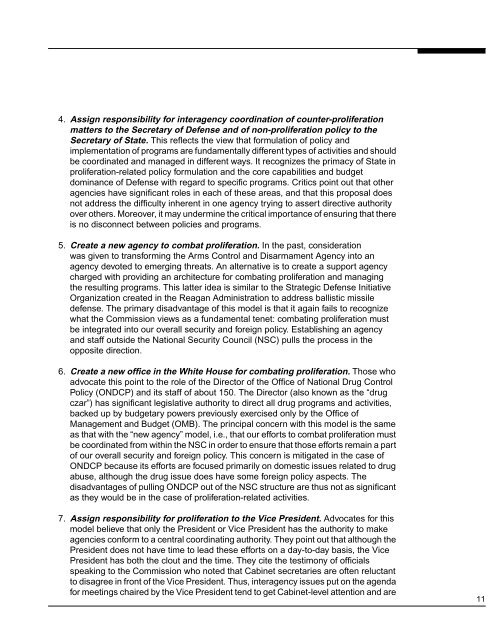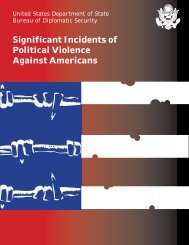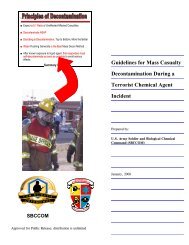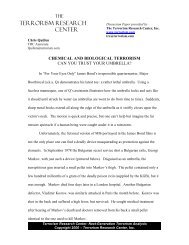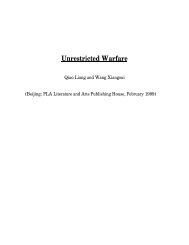Combating Proliferation of Weapons of Mass Destruction
Combating Proliferation of Weapons of Mass Destruction
Combating Proliferation of Weapons of Mass Destruction
You also want an ePaper? Increase the reach of your titles
YUMPU automatically turns print PDFs into web optimized ePapers that Google loves.
4. Assign responsibility for interagency coordination <strong>of</strong> counter-proliferationmatters to the Secretary <strong>of</strong> Defense and <strong>of</strong> non-proliferation policy to theSecretary <strong>of</strong> State. This reflects the view that formulation <strong>of</strong> policy andimplementation <strong>of</strong> programs are fundamentally different types <strong>of</strong> activities and shouldbe coordinated and managed in different ways. It recognizes the primacy <strong>of</strong> State inproliferation-related policy formulation and the core capabilities and budgetdominance <strong>of</strong> Defense with regard to specific programs. Critics point out that otheragencies have significant roles in each <strong>of</strong> these areas, and that this proposal doesnot address the difficulty inherent in one agency trying to assert directive authorityover others. Moreover, it may undermine the critical importance <strong>of</strong> ensuring that thereis no disconnect between policies and programs.5. Create a new agency to combat proliferation. In the past, considerationwas given to transforming the Arms Control and Disarmament Agency into anagency devoted to emerging threats. An alternative is to create a support agencycharged with providing an architecture for combating proliferation and managingthe resulting programs. This latter idea is similar to the Strategic Defense InitiativeOrganization created in the Reagan Administration to address ballistic missiledefense. The primary disadvantage <strong>of</strong> this model is that it again fails to recognizewhat the Commission views as a fundamental tenet: combating proliferation mustbe integrated into our overall security and foreign policy. Establishing an agencyand staff outside the National Security Council (NSC) pulls the process in theopposite direction.6. Create a new <strong>of</strong>fice in the White House for combating proliferation. Those whoadvocate this point to the role <strong>of</strong> the Director <strong>of</strong> the Office <strong>of</strong> National Drug ControlPolicy (ONDCP) and its staff <strong>of</strong> about 150. The Director (also known as the “drugczar”) has significant legislative authority to direct all drug programs and activities,backed up by budgetary powers previously exercised only by the Office <strong>of</strong>Management and Budget (OMB). The principal concern with this model is the sameas that with the “new agency” model, i.e., that our efforts to combat proliferation mustbe coordinated from within the NSC in order to ensure that those efforts remain a part<strong>of</strong> our overall security and foreign policy. This concern is mitigated in the case <strong>of</strong>ONDCP because its efforts are focused primarily on domestic issues related to drugabuse, although the drug issue does have some foreign policy aspects. Thedisadvantages <strong>of</strong> pulling ONDCP out <strong>of</strong> the NSC structure are thus not as significantas they would be in the case <strong>of</strong> proliferation-related activities.7. Assign responsibility for proliferation to the Vice President. Advocates for thismodel believe that only the President or Vice President has the authority to makeagencies conform to a central coordinating authority. They point out that although thePresident does not have time to lead these efforts on a day-to-day basis, the VicePresident has both the clout and the time. They cite the testimony <strong>of</strong> <strong>of</strong>ficialsspeaking to the Commission who noted that Cabinet secretaries are <strong>of</strong>ten reluctantto disagree in front <strong>of</strong> the Vice President. Thus, interagency issues put on the agendafor meetings chaired by the Vice President tend to get Cabinet-level attention and are11


